You might be here because you need tips on how to memorize quickly for that test come next week. Or maybe you have a theater rehearsal coming up and the character lines just won’t stick.
You’re in the right place then!
In this blog post, we will:
- Explain what memorization is.
- Learn how the process of memorizing happens in our brain.
- Show you what memorization techniques you can use to learn more material in less time.
- And hopefully, we’ll also teach you how to avoid memorization frustration by turning it into a fun, healthy headspace for your brain.
Shall we?
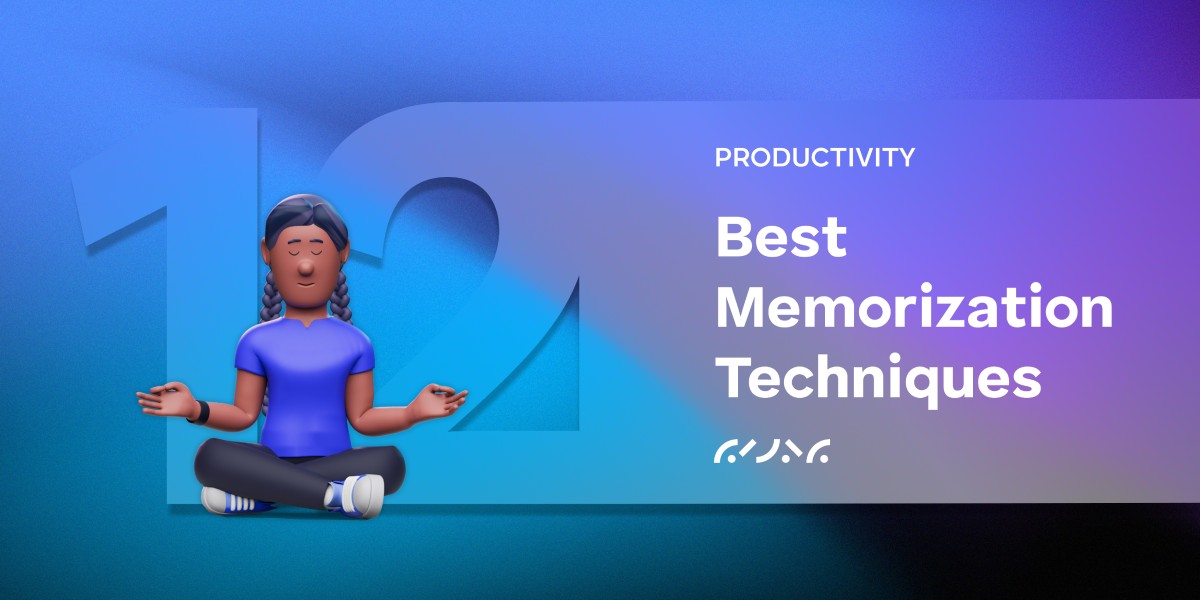
Table of Contents
What is memorization?
Let’s start with a short definition of memorization.
The Cambridge dictionary defines it as “the act or process of learning something so that you will remember it exactly.”
And, in real life, memorizing represents an important life skill. As we get older, so do our brains. It becomes so much harder to memorize things, learn new skills, or even study.
Memorizing is a great way to keep our brains active and slow down the inevitable neuron changes as we get older.
I don’t know about you, but I would hate to be one of those old people who can’t remember their own phone number or home address.
That’s why I want to make sure you understand the process of memorizing well. Let’s explain it first.
The process of memorizing explained
Our memory is our ability to encode, store, and retrieve information and experience.
Now, to better understand how we memorize all sorts of stuff, we will take a moment to explain four processes that occur in our brain when we are exposed to new information or experience.
These processes are:
- Encoding
- Consolidation
- Storage
- Retrieval
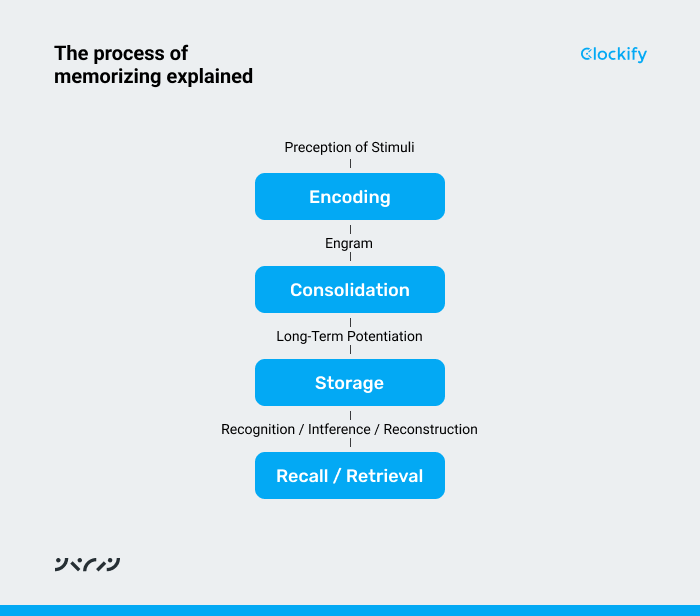
Let’s dive deep into each process.
Encoding
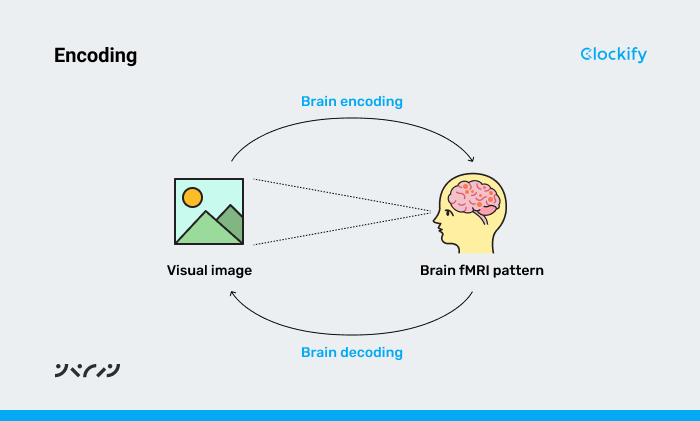
Encoding is the first step in the process of memorizing.
In short, encoding transforms internal thoughts and external events into our short-term and long-term memory.
During encoding, our brain processes and categorizes the information for storage and retrieval. Thanks to encoding, we are able to understand the information in a meaningful way.
Types of encoding
The three main types of encoding:
- Visual encoding: Converting a visual image to understand it as an object.
- Acoustic encoding: Encoding auditory information.
- Semantic encoding: Encoding of sensory input (concepts, ideas, or definitions) that has a particular meaning or context.
Consolidation
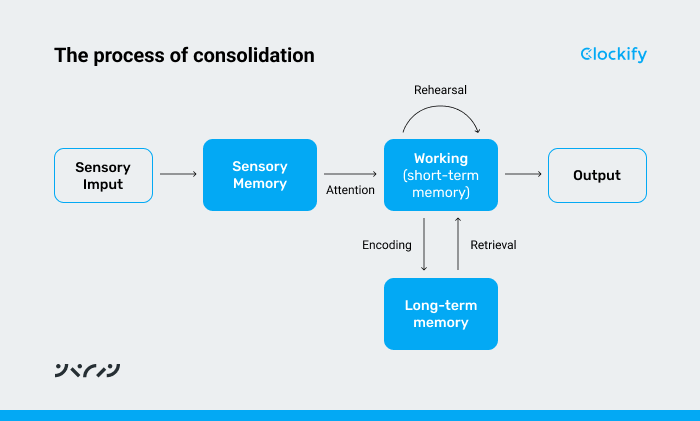
Consolidation represents the way in which memories are processed in the brain.
In other words, consolidation helps us narrow down the information from our short-term memory before they are converted into our long-term memory. It’s how our brain turns our short-term memories into long-term memories.
Types of consolidation
Two major processes lead to final consolidation:
- Synaptic consolidation: This happens in the first few hours of learning and encoding in the hippocampus and neocortex.
- System consolidation: With this, hippocampal memories become independent of hippocampus storage after some time.
Storage

After encoding and consolidation, the human brain stores the selected information.
To understand how the brain stores information, we can use the storage room analogy:
- Our brain is the storage room.
- Our memories are all the things we keep on the shelves of our storage room.
- Our brain keeps relevant information on the top shelves of our memory.
That’s why it’s always easier to remember things that we like or that matter to us — that’s why they will always be available on the shelves of our memory.
Where does our brain store memories?
Our memories are stored in several parts of the brain:
- The prefrontal cortex is where short-term memory is stored.
- The neocortex serves as an information processor.
- Basal ganglia are involved in processes like emotion, habit formation, reward processing, learning, and movement.
- The cerebellum plays an important role in fine motor control.
- Hippocampus is crucial for long-term memory but it’s also where episodic memories are formed.
- Amygdala is in charge of attaching emotional significance to memories.
Retrieval
Memory retrieval involves remembering the information or events that our brain previously encoded and successfully stored.
During memory retrieval, our brain replays the neural activity that was generated in the brain during a specific event or experience.
In this way, the brain recalls the information and details of the event. Memory recall shows us how creative our brain is and how it can gather relevant information from scattered, previously-stored information.
Types of retrieval
There are three main types of recall:
- Free recall: In free recall, we recall a list of items in any order.
- Cued recall: In cued recall, we remember a list of items with the help of cues and guides. With this type of recall, we often remember more than in free recall.
- Serial recall: In serial recall, we remember the events or items in the order they happened. This type of recall is helpful when you’re trying to remember events in chronological order.
—
Now that we’ve learned how our brain creates and stores memories, let’s see why memorization techniques are so important for us.
Why are memorization techniques important?
Back in 2017, there was a study that set out to prove how regular people could use strategies devised by memory champions and achieve the same long-term results.
Martin Dresler, one of the authors, mentions how even these memorization superhumans actually practice only a few weeks before a competition, for about half an hour to an hour per day. The rest of the time they can practice every once in a while.
However, he also states that no technique is going to help unless you actively commit to it.
So, to get the full benefit of the list of strategies we’re about to share, you need to make memorization practice a habit.
For example, whenever it’s time for a mental workout, you can track your time to see how long it takes you to recall something. To see real results, it’s also good to follow your progress.
Nowadays there are plenty of time-tracking apps such as Clockify that offer timesheets and graphs that display your progress over a select timeframe.
Additionally, you can choose one of the numerous habit trackers to ensure you get a little bit of practice every day or every few days.
So, let’s see what memorization techniques you can use to keep your brain active.
💡Clockify Pro Tip
If you’re eager to work more on building better habits, take a look at our two texts that explore this topic further:
Best memorization techniques
A memorization technique comes down to a very simple core guideline: transform a piece of information with no context so it makes sense to you personally.
And given how each brain has its own way of absorbing new information, memorization techniques are countless. To help you choose the best one for you, we will divide them into two groups:
- Verbal memorization techniques
- Visual memorization techniques
Let’s explore each category further.
Verbal memorization techniques
Do you have a way with words?
Do you rely on reading the instructions?
Do you remember all the lyrics almost instantly?
If you answered yes to some or all of these questions, you might benefit from verbal memorization techniques.
And we have some fun ones for you:
- Spaced out repetition
- Chunking
- Good timing for rhyming
- Laptops off — pencils out
- Spelling mnemonics: Stalactites or stalagmites?
- Helpful acronyms
- Association by medication
Stay tuned as we explain each memorization technique thoroughly.
Spaced out repetition
An oft-advised technique for better memorization, especially with exams and language learning is the spaced-out memorization technique.
Hermann Ebbinghaus coined the term “the forgetting curve”. It’s the graphic representation of how our brain forgets information over time unless it is repeated at certain intervals.
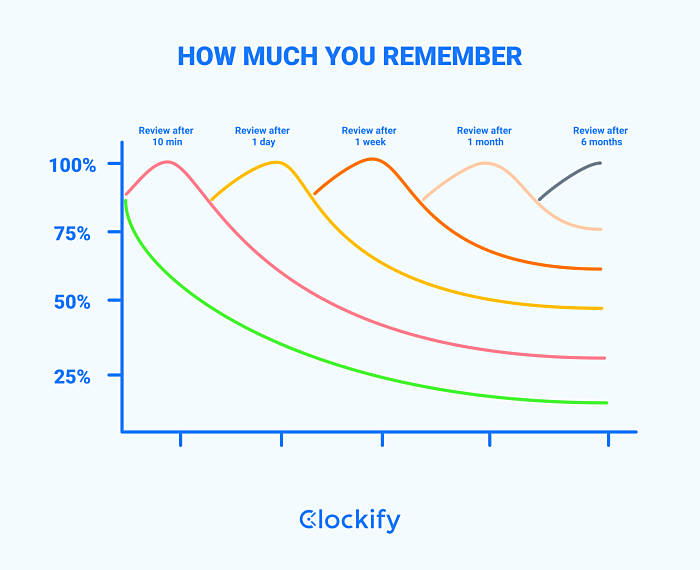
It’s also important that these reviews have a break of a day, two or more between them. As seen in the picture, the longer the gap, the more likely the information will remain memorized.
So, how can you apply it?
You probably have several things going on at the same time that you want to memorize:
- Preparing for a few tests.
- Learning several languages.
- Memorizing more than one poem, and so on.
You can log in to Clockify’s time tracker and create a memorization plan. Clockify also has a project tracking feature that you can use to make a schedule, and comes as a part of a special productivity bundle that can help you make the process of making a memorization plan a breeze.
Each project can be one subject or language. You then track the time spent memorizing for that particular subject.
After a full week, you’ll have an overview of how much time you’ve spent on each of them, and a schedule that can help you organize your learning time.
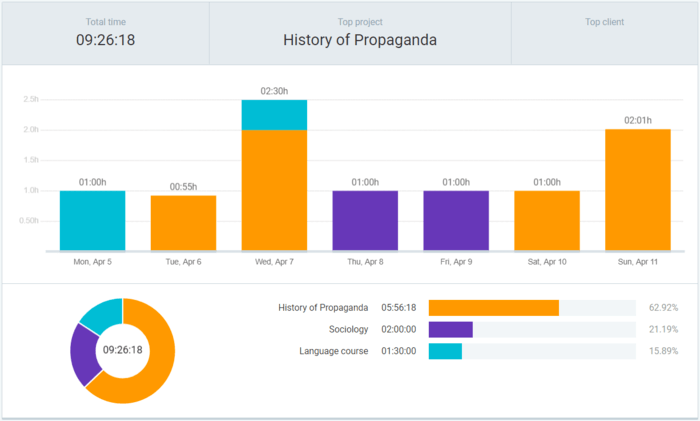
💡 Clockify Pro Tip
If you like templates, we have great free schedule templates you can use to organize your tasks, assignments, and other activities. Find them here:
Chunking
According to the APA Dictionary of Psychology, “chunking” is defined as “the process by which the mind divides large pieces of information into smaller units (chunks) that are easier to retain in short-term memory… one item in memory can stand for multiple other items.”
In other words, chunking allows you to group similar items together so you could remember them more easily.
But how many items can we group into a chunk to memorize them?
Back in 1956, psychologist George A. Miller analyzed the limitations of the human capacity for processing information. He discovered that we are (usually) limited to memorizing seven pieces of information at once. This became known as “The Magical Number Seven, Plus or Minus Two”.
So, whatever chunk you want to memorize — numbers, words, locations — you should make sure it has about 7 items (plus or minus two).
For example, chunking can be a great way to remember information if you’re managing multiple tasks or projects. You can group them by their deadlines, or subject matter — whatever seems logical to you will be fine.
Good timing for rhyming
Some of the things we remember most easily are commercials. Especially if they feature a catchy jingle.
Verse mnemonic techniques work much in the same way. The most popular one has to be the good old:
“Thirty days has September, April, June, and November.”
Most kids learned the number of days in a month thanks to it.
The same goes for the alphabet, or differentiating the colors of venomous and non-venomous snakes:
“Red and black, safe for Jack. Red and yellow kills a fellow.”
You probably know that our brains like patterns, which makes rhyming a great memorization tool. The only tough part is coming up with a rhyme that suits your material and needs.
Laptops off – pencils out
As a rule of thumb, it is often pointed out how writing makes you memorize better. Choosing laptops over note-taking could actually be robbing you of remembering lectures or meetings better.
Why?
As we write down lectures or any other spoken/dictated information, we force our minds to filter out which pieces of information are more important than others.
We stop being mere listeners and actively participate in absorbing new knowledge.
In contrast, some studies show that those who type out their learning material tend to do it word-for-word. Writing, on the other hand, forces us to formulate the learned in our own words — making it much easier to recall it later.
Spelling mnemonics: Stalactites or stalagmites?
There are cases when we find it particularly hard to remember a word because it sounds awfully familiar to something else. Such words are affectionately dubbed “the confusables”.
For example, people often mix up stalactites and stalagmites. Which ones rise from the ground, and which ones hang from the cave ceiling? Can you tell?
In an interesting Twitter debate, many users shared their techniques for remembering which is which:
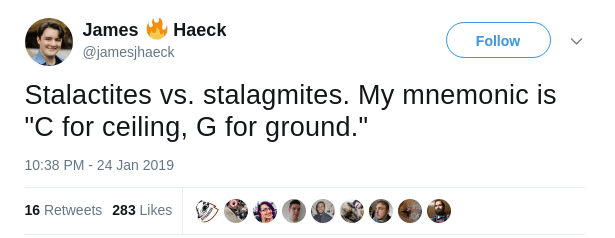
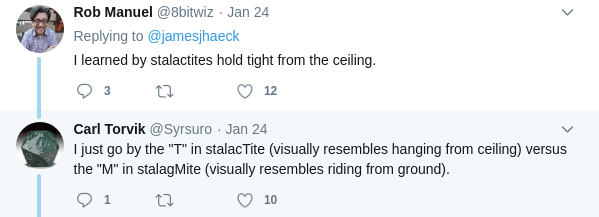

With the techniques like the ones used above, you relate a part of the word to something that makes a logical auditive or visual connection to its meaning (shape of one of the letters, or the sound of the latter part of the word).
Helpful acronyms
If the order of items on a list is potentially important, you can use their first letters to make up a sentence. A very well-known example of naming planets in order:
“My Very Easy Method Just Speeds Up Naming Planets”
I’m sure you can easily remember all the planet names after this, don’t you?
And what about SMART goals?
It’s much easier to remember the steps when you memorize the acronym:
- S for specific
- M for measurable
- A for attainable
- R for relevant
- T for time-bound
This technique can be helpful if you struggle with remembering names — but you can adapt it to whatever suits you. Why don’t you give it a try and see how it goes?
Association by medication
In an article on memorization struggles throughout med school, Shiv Gaglani shared an interesting technique he came by.
He mentions that one of the hardest things medical students and doctors alike have to memorize are the side effects of certain drugs.
However, one day, as he was reading the news on the cyclist Lance Armstrong’s then-discovered cancer, he found out that the man refused cancer.
The main reason was the active ingredient in the treatment – bleomycin. Bleomycin can cause lung deterioration which, being a passionate athlete, Armstrong was afraid of.
This association cemented bleomycin in Gaglani’s memory. So much so, that it inspired him to create Osmosis for medical school students, but also advises association technique to everyone who isn’t one.
If you’re struggling with a particular historical figure, a periodic table element, or the name of a city, associate it with an interesting bit of trivia.
Visual memorization techniques
Verbal memorization techniques might not work for everyone. And that’s okay.
You are probably a visual learner and could do great with a few visual memorization techniques.
We’re going to explain the following memorization techniques:
- The link or story technique
- When in doubt — act it out!
- King of your memory palace
- Create your own flashcards
- Mind map to fill the gap
Let’s begin!
The link or story technique
The link or story memorizing method is a great solution for creative minds.
It’s also one of the best ways to remember a long list of items or information.
The best thing with this memorization technique?
You only have to remember only the first item from the list and then link it to all others with the help of pictures and visualizations. Let’s illustrate this with an example.
Let’s say I want to remember a list of chores for tomorrow:
- Take the kids to school
- Go to the bank to close the bank account
- Print out a document for work
- Pick up the kids from school
All life exists on planet Earth, so that’s going to be my starting point for this technique.
- Being a nerd, the first thing that comes to mind is the school on that planet.
- Next to the school is the bank — because money makes the world go round!
- And this money better be of paper — I prefer to put everything on paper.
- But of course, my kids love to find my papers and use them for drawings.
I hope this will inspire you to try the link or story technique the next time you have to remember all of your chores.
When in doubt — Act it out!
Have you ever wondered how theatre actors can memorize pages and pages of text for a two-hour play and not stutter?
Well, the secret, as found in a 20-year-long study, is in attributing emotions to every dialogue scene. Actors work hard on understanding why a specific character said what he did and try to embody that emotion.
As a memorization technique, you can try to approach your learning material as a story. This proves to be especially useful for history lessons or remembering events.
Treat the material as a plotline to a movie, and the people as characters with specific motivations.
Additionally, if you need to memorize lines (whether it IS for a play or an audition), many aspiring actors mention the RehearsalPro app as a good acting partner.
King of your memory palace
Another visual memorization technique on our list is the Memory Palace (Journey Method, or Method of Loci), very well known and used among memory champions.
It’s most useful when you need to remember long lists of words or numbers, like the decimals of Pi, or a shopping list.
The trick here is to imagine a familiar place, like your house or an apartment. Then, you put each item from the list inside the house. Here’s a simple example:
Take the word list: bear, window, dream, slimy, fridge, broom.
Break up the list into two groups by three items.
We’ll imagine a house porch, and place the first three items on it:
- The bear is on the railing, sound asleep.
- Inside the windows of the house, you see aquarium fish swimming.
- There is a dream bubble above the bear’s head and he dreams of honey.
For the second group, we move on inside the house:
- As you grab the doorknob, you notice it’s slimy with green goo.
- In the hallway, there is a fridge whose doors are open and it fills the room with snow.
- Near the staircase, a broom is whacking at a spider in the corner.
Try to sit back now, and don’t look at the list above. Can you picture the house again, retrace the steps and recall all the items?
By creating outlandish imagery, you go against the brain’s perception of how the real world works. The images stand out, making those items easier to remember.
Create your own flashcards
If you like writing things down but also give them a personal touch with unique sketches, colors, or images — you should consider the flashcard memorization technique.
Flashcards allow you to break the information down into smaller, meaningful chunks that are easier to memorize.
The good thing about flashcards is that you can:
- Combine them with other memorizing techniques like the spaced-out repetition.
- Rely on them during lectures to remember the important info you should talk about.
- Use them discretely as safety reminders when delivering a speech.
Be careful though, the way you make your flashcards also matters. To make your flashcards as effective as possible, avoid complicating them, using only pictures and no words, and overusing them.
Mind map to fill the gap
Mind maps are an amazing memorization technique that helps you brainstorm ideas and visualize relevant information later on.
Some of the benefits of the mind mapping technique include:
- Allowing you to learn more meaningfully.
- Helping develop your mental capacities.
- Enabling you to understand complex problems much easier.
- Boosting your productivity.
- Makes the memorizing process more fun.
According to Hazel Wagner, a lifelong learner with a Ph.D. in mathematics, mind mapping is a memorizing technique that helps you make notes, take notes, and help your memory.
In one of her TedTalks, Wagner explains in great detail what mind mapping can do for our understanding, memorization, and retention. She particularly emphasizes the importance of personalizing our mind maps so that we can easily retrace our steps when we look at them later on.
So the next time you’re making a mind map, make sure to do it in a personal, relatable way and you’re very likely to succeed.
💡 Clockify Pro Tip
If you’re looking for more ways to boost your productivity, check out some useful techniques that can help you achieve that:
10 Popular memorization software and apps you can try
If your goal is to improve memory for the long term, then turning memory games and practices into a semi-regular habit is crucial.
Even if you aren’t devoted to training your body, you should train your mind.
Many advise picking up a musical instrument, signing up for a course, or learning a new language.
But, there are also plenty of online resources that can take as little as five minutes out of your day.
We’ve set aside several that are popular among people seeking memorization help.
Lumosity
This is by far the most famous app in the market, currently. Lumosity hasn’t been proven to actually make one smarter, but its mini-games and exercises are guaranteed to keep your brain quick and active.
Neuro Nation
With a slightly different approach, Neuro Nation assesses your mental strengths and weaknesses to find areas for improvement, then tracks your progress over time.
It also features numerous colorfully designed challenges and for the more competitive types out there: pits your score against other users.
Elevate
Elevate is an app that helps you stay sharp, build confidence, and boost productivity. Thanks to its extensive game archive with more than 40 games, you can improve your skills (math, reading, writing, speaking, and recall) and track your progress.
Flashcard Machine
If you’re a flashcard enthusiast, Flashcard Machine is a free service that you can use to create study flashcards online and share them with others. Up to date, more than 125 million flashcards have been created with this service — by teachers, students, and business professionals.
Anki
Anki is another memorization-centered software. It was made to accompany you whether you’re learning a new language, memorizing complex formulas, or learning a poem. It has flashcards and strategies for every discipline.
Kahoot!
As a great game-based learning platform, Kahoot! Allows you to easily make, share and play learning games or trivia quizzes in minutes — these are also known as “kahoots”. It’s designed for educational, business, and informal settings — just make your pick!
Peak — Brain Training
The games that Peak — Brain Training offers are designed to push you hard with short, intense workouts designed around your life. The app helps you test, challenge, and work on some very important skills — focus, memory, mental agility, problem-solving, being only some of them.
Quizlet
Quizlet is a great option for teachers and students. You can search its comprehensive database of pre-made study sets that cover thousands of topics or make your own custom study sets.
Thanks to modern teaching technologies such as text-to-speech audio, images, interactive diagrams, and progress tracking, Quizlet makes studying more engaging and effective.
Brainscape
Brainscape is one of the best web and mobile education platforms designed to tend to visual learners, especially those who rely a lot on making flashcards.
The app allows students, teachers, and corporate trainers to make their own electronic flashcards but also to find flashcards other global users and publishers created.
Quizizz
Quizizz is an educational software that provides students with an engaging learning platform. The Quizizz is a helpful tool for in-class and group assignments. Moreover, teachers can also use it for pre-test reviews, formative assessments, and pop quizzes.
Final thoughts: Improving your memory can’t be a one-time thing
Whichever method you choose, keep in mind that memory improvement doesn’t work as a one-time solution.
In the past two decades, we’ve become increasingly reliant on having phones and computers as memorization crutches. But if we understand it as an investment in our future mental health, improving our memory capacity can become another form of self-care.
Yet, as we move forward in our careers and life, we’ll realize that being quick-minded can be an invaluable asset. Improving our memory can:
- Boost our productivity.
- Improve our workflow.
- Enhance our time management skills.
Before you find the memorizing technique that suits you best, remember to try them out first. No matter if you want to learn a new language or excel in an exam, these memorization techniques should make it much easier and quicker.
✉️ Are you trying to train your brain to memorize faster? Do you use any special techniques, software, or apps to do that? If you are, let us know at blogfeedback@clockify.me — we may include your tips in this or a future blog post!



